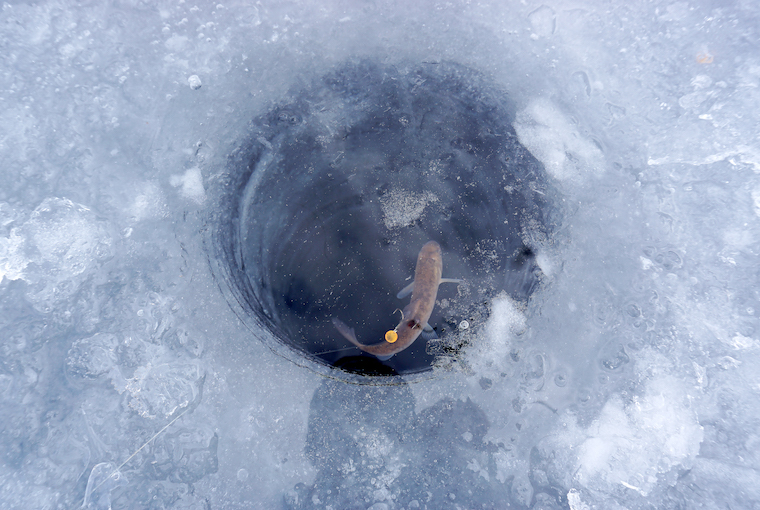
From the darkened tent, I gazed into the crystal-clear underwater world. The bottom was sandy, with a few wisps of weeds and occasional rock. My silver-and-green jigging spoon danced enticingly 15 feet below. Yet, it had been a quiet morning, with only a some herring seen and one whitefish landed.
Some family members and I had been on the ice early targeting steelhead, but they were proving scarce. Then, unexpectedly, a silver rocket roared in and took a swipe at my flashing chunk of metal. I didn’t feel a strike but since the fish was visible, I instinctively set. That pulled the lure away and the steelhead was gone just as fast as it appeared.
“Noooo,” I groaned, jigging even more intensely. Had I blown my only opportunity?
Just as I was about to give up hope, the trout came back, and this time it engulfed the spoon, gills flaring. The hook found flesh and my jigging rod bent towards the hole as line peeled off.
“Steelhead on,” I yelled, so my fellow anglers in the two other ice tents could hear me. Soon, Gord Senior was peeking into the door of the tent. “What’s happening in here, son?” he said with a smile.
The trout was putting up quite a fight, but its silver sides were now flashing just under the hole. When the head was in, I lifted the rod sideways and the 22-inch chrome trout swam up and slid out. The hen steelhead lay still and glistened on the floor of the tent. It had almost none of the red/pink blush it would sport during the spawning run, which was less than a month away.
“What a beautiful creature,” Senior said with admiration. After a quick pic, the hook was twisted free, and the steelhead swam off strongly.
“See you in a couple of weeks,” I said.
Steelhead are one of the more prized — and challenging — fish to catch through the ice. They are nomadic and tend to stay higher in the water column than most other trout. My steelhead fishing has been done on Lake Superior, yet the techniques and tricks outlined here can help any angler wrangle steelhead (and inland rainbow trout) through the ice.
Let’s look at the locations, techniques and terminal gear that can help you ice some steel.
Where to fish
In general
On ice in the Great Lakes, areas within striking distance of a spawning river or two are never a bad choice. That does not mean, they will always be holding at the mouth of the river. Steelhead are a cruising fish and use breaks in the shoreline as hunting areas. Points, piers, breakwalls, rock piles, and even sandbars will be potential steelhead magnets.
River flats
There are also times that steelhead roam huge flats, looking for suckers, smelt, sculpin, and whatever else they can get down the hatch. These areas don’t look too impressive on a map but are worth a try. Some big, shallow estuaries of major rivers fill this bill. The bite is random, but steelhead are apex predators and have few worries about predators. Cruising structureless areas allows them to eat whatever preyfish or insects are around. Not many minnows can outrun a steelhead. Pockets of weeds on these flats will hold more insects and baitfish, so they also potentially attract more steelhead.
Best for late season
Towards the end of winter, as the spawning run approaches, steelhead will become more abundant closer to the spawning streams. This is also when you may find a few fish swimming together. Staging steelhead will often be found in water 10 feet or less then. This creates the perfect scenario for sight fishing (see below).
Lures
Spoons
Spoons are the simplest presentation and work amazingly well in different scenarios. The heavier jigging spoons, such as the 1⁄2 ounce Swedish Pimple, Northland Buckshot, Crippled Herring, and Hopkins Smoothie are better in deeper water from 15 to 25 feet or so. They get down fast and have a good thump. In shallower water, lighter spoons including the 1⁄4 ounce Williams jigging spoon, EGB, Little Cleo, Northland Macho Minnow, Mooselook, and Al’s Goldfish Ice Jigs are killers. Lighter spoons fall more slowly and account for a lot of fish.
Gliding jigs
The Jigging Rapalas and Northland Airplane Jigs have actions that can elicit strikes when spoons can’t. The airplane jig falls slowly and covers more area while doing so. I use it with a full minnow and stinger. The Jigging Rapala benefits from the addition of a minnow head on the centre treble. An airplane jig can also be fished in tandem with a tube.
Tubes (for finesse or follow-ups)
Tubes work very well on steelhead and are a much more subtle presentation. A tube’s octopus-like legs and softness can be great when steelhead are pressured or the bite is off. I sometimes add a stinger to the main hook to get short-striking fish. Four-inch tubes that are white, pearl, red/white or smoke all have proven themselves. A tube is also a good follow-up lure if a steelhead has come in for a spoon and rejected it. Tubes shine in water of 10 feet or less.
Swimbaits and hair jigs
Plastic swimbaits of four or five inches on a quarter-ounce head are very effective. Bucktail and marabou jigs are another good in shallow water, and are a popular choice when steelhead are starting to stage. Other good choices are hair or marabou jigs with red, orange or chartreuse colours.
Live baits
Where rules allow an angler to fish two lines, I recommend setting a second line with bait. Many choose to use roe bags and that works, but I’ve had quite a bit of success hanging large minnows or suckers. It can also account for the largest fish.
Last winter, my father hooked up a sucker on a jig and hung it off a set line. The set line was simply an ice jigging rod that sits on a balance. When the fish hits, the rod tilts down. Senior’s minnow was making that rod tip bounce a lot, due to its size and liveliness. At one point, the minnow went bonkers and then completely stopped. We looked at the rod and it was slowly tilting down. Fish!
Gord senior slipped over, tightened up the drag and set the hook. The rod quickly revealed that this was a big fish. However, the fight was surprisingly short. That steelhead had hit in shallow water and my father had it out of hole before it knew what happened. It was a big, hook-jawed male, and was sporting the red slash that gives rainbow trout their name. It had crushed a five-inch sucker minnow like it was a Tic Tac.
Originally published in the Jan.-Feb. 2023 issue of Ontario OUT of DOORS


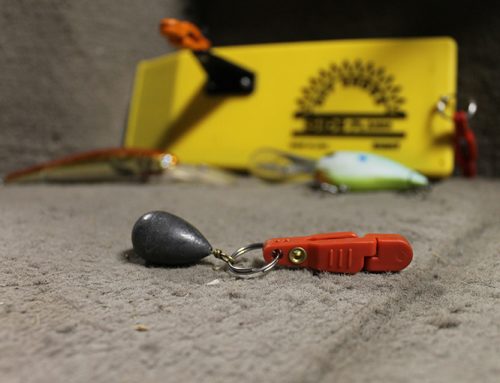
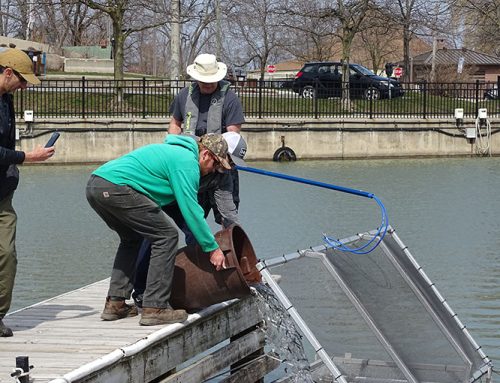
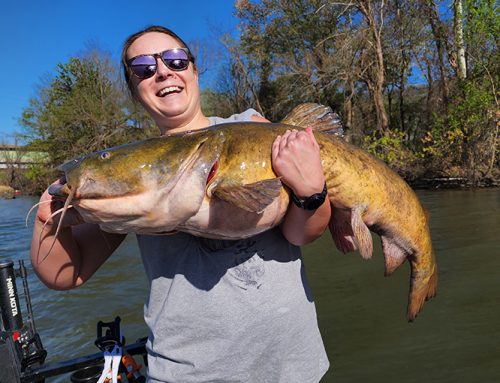
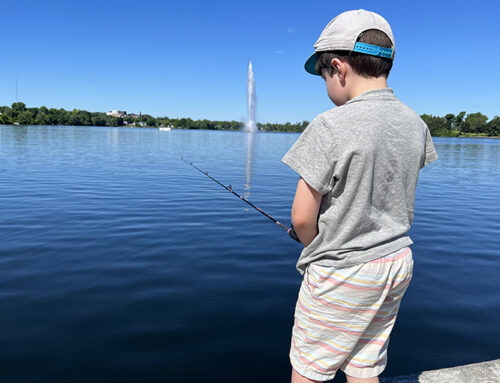
Leave A Comment